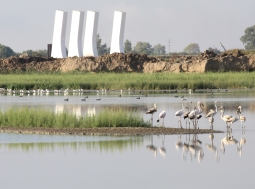Drawbridges on Seville’s New Locks Pass Tests AOK
The FCC-built will make greater sea transport possible

At the new locks built at the port of Seville by FCC in a Joint Venture, the installation of the traction, actuating and control mechanisms of the four locks and of the three drawbridges has now been completed, they having passed the first tests for checking their proper working order.
The electromechanical system installed makes it possible to operate the 293.65 m, 800-ton lock gates safely and accurately. Built at the Seville shipyard, the four door frames and the in situ-installed traction, guide and control mechanisms have been completed.
On each one of the drawbridges, two road bridges measuring 44 m by 12 m in width plus a railway bridge of the same length by 6.10 m in width, a hydraulic system has been installed making it possible to raise the 200-ton bridge deck within three minutes' time into an upright position totaling 40 meters in height. The new drawbridges substantially improve the internal connectivity of the port area between the left and right banks of the port area and the accessibility of the inbound and outbound port area traffic to the future SE-40 beltway.
At completion of the concrete frame, these tests validate the operativity of the gates and drawbridges and open up the way to the final construction phase consisting of closing off the river and the bypass of the current lock, making it possible to improve the traffic of this interior space.
The new lock is replacing the former one which has been operating for over 60 years, thus making it possible to broaden and improve the ship canal. Set out in the development planning, with an investment of nearly 200 million euros, it will be making it possible to considerably increase short-distance sea transport, which could total 12 million tons over the next few years, in comparison to the 5 million tons currently transported. This would mean: saving 14 million euros on fuel yearly, reducing NOX and CO2 emissions by 350 and 250 tons, respectively, creating 15,000 new jobs over the upcoming ten-year period and guaranteeing the protection of Seville.
In addition to improving transport and facilitating the city's development, the project of this new lock has a highly important environmental aspect, has been conceived based on approaches integrated into environmental sustainability, upheld by the different environmental institutions. The preliminary measures entailed geotechnical prospecting, the drafting of an archaeological intervention project, as well as a report on the protected flora and fauna. Strict compliance with the environmental surveillance program has also been assured.








